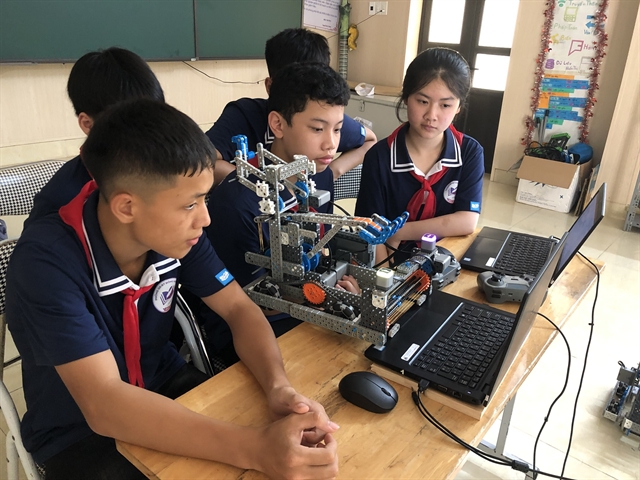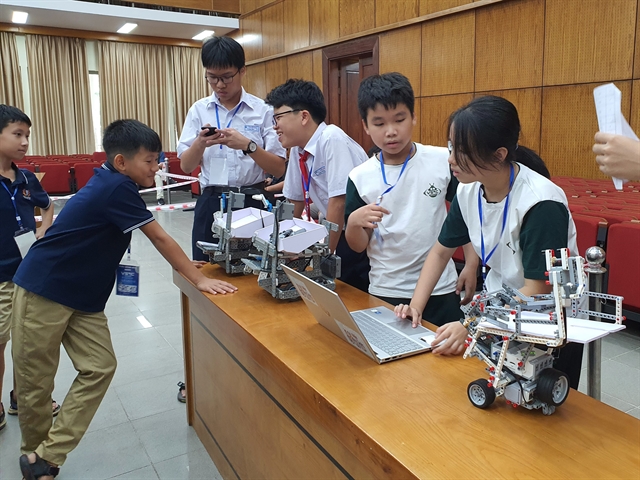 Society
Society

 |
| A robotics team review their robot programming at Đông Các School in northern Thái Bình Province. — Photo courtesy of Đông Các School. |
Nhật Hồng
HÀ NỘI — While STEM education has only made its way to official guidelines in recent years, multiple initiatives have been rolled out across the country to allow students of all age groups access to this interdisciplinary learning approach.
STEM education has clearly had positive impacts in the local academic sphere, teachers say, but this is only the beginning of a challenging road.
Notably, STEM (science, technology, engineering and mathematics) education was identified as a focus for the general education curriculum per the Prime Minister’s Directive 16/CT-TTg in 2017.
The Ministry of Education and Training in 2020 also issued an official document detailing the implementation of STEM education in secondary and high schools across the country.
Since then, multiple national STEM forums have been made available for school children such as the national STEM Festival and its numerous competitions and championships.
Lê Thị Chi, the teacher in charge of the robotics subject at Đông Các School in the northern province of Thái Bình, says that the impact of STEM education on her students is obvious.
“They know how to make a specific plan to reach a goal through learning robotics and programming.
“STEM education also changes their way of thinking by training them to detect and solve problems,” says Chi.
Particularly in robotics, Nguyễn Diệu Thúy, a teacher from Tân Tiến Secondary School of Hải Phòng City, saw how students develop their critical thinking skills by applying what they learn in science and technology classes.
She adds that STEM subjects also allow them to freely explore new knowledge using computers and technology, instead of games or TikTok and Facebook.
As students often learn STEM and even compete in STEM contests in groups, they also learn to work together.
“The benefit of working in teams is that they have to establish a working process for teamwork, determine the role of each member, and each of them will own the responsibility for their part,” Chi adds.
More attention given to STEM also means an increase in school clubs, designated teachers for the subjects and STEM festivals serving as platforms for children of all ages to explore their interests in STEM fields.
Seventh-grade student Nguyễn Lê Ngọc Khánh in central Đà Nẵng City has been learning robotics since she was in Grade 2, and started joining STEM competitions two years later.
Khánh says: “Learning STEM is quite fun for me and also provides me with new knowledge, especially about programming and designing robots.
“Contestants have many great ideas for their robots and find ways to optimise them. I also gained more experience to do better in the next contests.”
Ngô Minh Khôi, a sixth-grade student also from Đà Nẵng City, found his passion in programming robot movements by joining these contests, and plans to continue training himself for the coming years.
These competitions also serve as an educational playground for children from different schools and regions.
Vũ Thùy Chi, the robotics club leader of Hải Phòng’s Tân Tiến Secondary School, says about her experience in one of these contests: “It’s quite fun when our robots could work with those from other teams.
“They are very friendly and we also learn more about their way of assembling and programming the robots,” she says.
Tân Tiến School’s robotics team is relatively new to the game, having only been formed last year.
Led by Thùy Chi and lead programmer Trần Thanh Hương, the group has been gearing up and is now looking forward to city and national-level STEM competitions with the support of their teachers.
“We’re really grateful to my school for investing in our club with robotic equipment, practice field and even supporting us financially to enter contests,” says Thùy Chi.
 |
| Students assemble a robot in Tân Tiến Secondary School in Hải Phòng City. — Photo courtesy of Tân Tiến Secondary School |
Nguyễn Sĩ Nguyên, a robotics team coach from Đà Nẵng City, underlines that STEM education is about learning by doing in actual situations which teachers integrate into lessons in a way that students understand what they are studying, and what is the practical use for that knowledge.
It also means instilling excitement in students rather than passive learning.
“By applying knowledge to resolve real-life situations, students develop flexibility and develop themselves, that’s my point of view,” says Nguyên.
Lê Thị Chi, robotics teacher at Thái Bình’s Đông Các School, shares the same perspective, having witnessed how mature her students have become through STEM competitions.
They were very shy and timid, but when the national Vietnam STEM robot competition (VSRC) required forming leagues, they actively looked for partners and identified their strengths so the team members could complement each other in the games, says Chi.
“Although they didn’t make it to the finale, their scores visibly improved. Those changes were thanks to their communication and coordination skills gained during the competition,” she adds.
Challenges ahead
Despite the benefits that come with the emergence of STEM education, both teachers and students found themselves facing a significantly larger amount of knowledge when the 2018 general education curriculum shifted the focus to interdisciplinary education
Most teachers, who received their pedagogical training before the change, were also taught per their majors such as Maths, Biology or Physics, rather than the encompassing Natural Sciences subject in the new curriculum.
There are also few courses that offer teacher training for interdisciplinary subjects, says Chi.
Noticing these challenges, the STEM Education Promotion Alliance (SEPA) has been connecting with local education departments to provide support to as many STEM teachers as they can.
Đào Thị Hồng Quyên, head of the alliance and also a STEM educator, says that SEPA focuses on a ‘train the trainer’ model for teachers, who have access to numerous cohorts of students throughout their careers.
Quyên recalls that official training courses would usually gather several representatives from each locality and required them to make reports as a way to pass on the knowledge to the rest of the teaching staff.
The downside to this approach is that teachers did not have time to practise before they have to finish the reports for their colleagues, Quyên explains, and therefore a lot of things are lost in transmission.
“We think that education development should be fair, and the more opportunities offered to people, the more equal we are,” says Quyên.
SEPA gathers STEM education experts at its core and expands its community of STEM educators through training courses at the local level and their online community where they share learning resources and opportunities for both students and teachers.
With more than 16,000 members across the country, the online platform is also where they maintain a continuous flow of exchanges between teachers beyond the in-person training from SEPA, which leans more on providing STEM lesson models.
In addition to skills improvement, teachers also look forward to better infrastructure for their students in learning STEM, which plays a major role in providing them with hands-on experiences and letting them apply theories into practice.
 |
| Secondary school students prepare their robots in a STEM competition in Hà Nội. — VNS Photo Nhật Hồng |
Tân Tiến Secondary School’s teacher Nguyễn Diệu Thúy says: “We are still figuring out on our own how to create items for STEM learning from scratch.”
Specific instructions would be helpful to facilitate this process for both students and teachers, she says.
For teacher Lê Thị Chi from Đông Các School, it is necessary that not only educators but also parents understand the role of STEM for their children.
“When parents are aware of the role of STEM education, they will readily assist and support their children more in their intellectual growth.” — VNS




